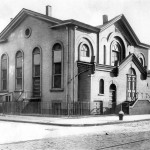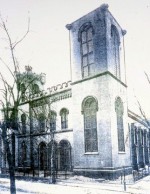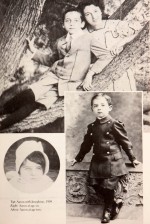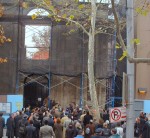Our History
“Remember the days of old, consider the years of ages past”
– Deuteronomy 32.7
In 2006 Kane Street Synagogue celebrated its first 150 years with the publication of The Synagogue Journal. This online journal features the Congregation’s first fifteen decades through Brooklyn Daily Eagle articles, synagogue archives and personal reminiscences.
The Synagogue Journal Archives »
Contact at [email protected]
Beginnings of Brooklyn Jewry
Historically known as The Mother Synagogue of Brooklyn, Kane Street Synagogue is the oldest Jewish Congregation that still serves the Brooklyn neighborhood in which it was founded. Founding members of our predecessor Congregation Baith Israel included attorneys and tailors, a hatter, furrier, barroom owner, mason, rabbi, pawnbroker, builder and carpenter. The members of the congregation were mostly German or Prussian immigrants who had been affiliated with synagogues in lower Manhattan. When those synagogues relocated uptown, the men from Brooklyn organized on their side of the river near the South Ferry terminal at the foot of Atlantic Street. In 1855, before establishing the Congregation, several Baith Israel founders organized the United Brethren Society, which provided its members with medical care, funeral benefits, a plot and tombstone. Within a year Brethren leaders and others incorporated Congregation Baith Israel, rented space for a synagogue at 155 Atlantic Street and engaged a Chazzan for the High Holidays, Passover and Shavuot. Rev. Joel Alexander served as the congregation’s first fulltime rabbi. Rev. Alexander, a graduate of the Jews Seminary in Munster, Prussia was ordained by the Posen rabbis and by Dr. Adler, Chief Rabbi of London, England.
Boerum Place Synagogue
By 1862 Baith Israel erected the historic Boerum Place Synagogue at the corner of State Street and Boerum Place near Brooklyn City Hall. This was the first building in Brooklyn to be built as a synagogue. The Rev. Rabbis Morris Raphall (from B’nai Jeshurun) and Samuel Myer Isaacs (from Sharey Tefilah) officiated with Rev. Alexander at the dedication. Accounts of the ceremony in the Brooklyn Eagle describe the interior of the sanctuary as having a traditional Orthodox layout with pews for men arranged around a central reading table and separate gallery seating for women.
Baith Israel’s Sunday school, the first Jewish school in Brooklyn, met in the synagogue’s basement meeting rooms. The school began in 1864 as a free institution with volunteer teachers from the Hebrew Free Sunday School teacher’s association. Classes for boys and girls met separately. Bar Mitzvahs and confirmations for boys were held several times a year. On Sukkot in 1873 Rev. Dr. Tintner led the first Confirmation services for girls. Eventually, the Congregation began confirming boys and girls together during Shavuot, a custom practiced until the 1940s.
Conflicts about ritual practice go back to the Congregation’s beginnings. In 1861, the same year the Southern states broke from the Union, a group broke from Baith Israel to form Beth Elohim. During this time of dissension, factions were often volatile. In 1866, a fight broke out on the bimah between Baith Israel President Solomon Furst and Rabbi Ekan Herzman. On several occasions Baith Israel attempted to merge with Mount Sinai, Beth Eloheim and Temple Israel, but the consolidation failed when the congregations couldn’t agree on customs. Reforms at Baith Israel occurred incrementally. In 1879 a renovation relocated the Ark to the end of the Sanctuary and the pews all faced the same direction. More significantly, the congregation introduced mixed seating. Although the Brooklyn Eagle referred to the Boerum Place Synagogue as the “Polish Congregation” or “Orthodox” and the only Brooklyn synagogue still adhering to the traditional two-day holiday observance, the Congregation was in the midst of great change. High Holiday Morning Services lasted only two hours. Sermons were delivered in English rather than German. The Anglicized name “Beth Israel” was often used instead of “Baith Israel”. Confirmation rites were held for thirteen-year-olds.
Controversies over ritual practice resulted in a succession of Rabbis. Although each rabbi struggled to balance tradition and reform, none was strong enough to lead the diverse membership. In 1893 the charismatic Rev. Marcus Friedlander left Baith Israel after five years and relocated to the more liberal First Hebrew Congregation of Oakland, California. Curiously, the minute books and financial records during Rabbi Friedlander’s tenure were removed from our archives and his name deleted from our early histories. Membership declined after a fire in 1904 that nearly destroyed the synagogue. The decision was made to sell the Boerum Place Synagogue and move to a larger building.
Rabbi Israel Goldfarb Years: 1905-1961
 In 1905, the Congregation moved to its present home on Kane Street, which until 1928 was known as Harrison Street Synagogue. Both the sanctuary and meeting building were built in 1855 as a Middle Reformed Protestant Dutch Church. Interim owners of the property were the Salvation Army and the Trinity German Lutheran Church. Baith Israel dedicated the synagogue on Washington’s Birthday, joyfully placing the sefer Torahs in the Ark that was relocated from the Boerum Place Synagogue. By August, Israel Goldfarb, a recent Jewish Theological Seminary graduate from Sieniawa, Austria Poland, started in the position of Chazzan and Sunday school director. Rabbi Goldfarb became the synagogue’s rabbi the following year and served as its spiritual leader for sixty years.
In 1905, the Congregation moved to its present home on Kane Street, which until 1928 was known as Harrison Street Synagogue. Both the sanctuary and meeting building were built in 1855 as a Middle Reformed Protestant Dutch Church. Interim owners of the property were the Salvation Army and the Trinity German Lutheran Church. Baith Israel dedicated the synagogue on Washington’s Birthday, joyfully placing the sefer Torahs in the Ark that was relocated from the Boerum Place Synagogue. By August, Israel Goldfarb, a recent Jewish Theological Seminary graduate from Sieniawa, Austria Poland, started in the position of Chazzan and Sunday school director. Rabbi Goldfarb became the synagogue’s rabbi the following year and served as its spiritual leader for sixty years.
The synagogue flourished during the early decades of Rabbi Goldfarb’s tenure. In 1908, Baith Israel merged with Talmud Torah Anshei Emes, a Degraw Street Shul whose members practiced strict Eastern European traditions. This blended Congregation, Baith Israel Anshei Emes, BIAE, presented tremendous challenges for its leaders. While the majority of pews held mixed seating, the bruderen from Anshei Emes occupied an all-men section of pews at the front left of the sanctuary. The celebrated composer Aaron Copland, a 1913 Bar Mitzvah, recalled in his autobiography that “On Yom Kippur, the Day of Atonement, the elder greybeards of the Congregation stretched themselves out prone in the aisles of the synagogue and prayed for forgiveness of man’s evil ways.” Throughout his years at BIAE, the presence of two traditions at the synagogue challenged Rabbi Goldfarb to find creative, practical solutions to ritual practice. When women were added to the choral group, the Rabbi moved the choir from the main floor of the sanctuary to the organ loft, where their presence would be less offensive to traditionalists who preferred separate seating.
In his book “Copland 1900 Through 1942” the composer acknowledged Goldfarb’s influence on his life. Without his encouragement, Copland may not have pursued his music studies in Paris. As a high school student Aaron enlisted the rabbi’s help to convince his father to let him study music instead of law. “By curious coincidence our rabbi, Israel Goldfarb, was himself a composer of liturgical music and the possessor of a fine baritone voice. Rabbi Goldfarb was a sensitive human being and an effective leader of his congregation.” Rabbi Goldfarb enhanced Shabbat and holiday services with music. He brought in choral directors for the children’s and adult choirs and introduced congregational singing to the service. He compiled ten books of music, including The Jewish Songster. He is known for composing the melodies to “Shalom Aleichem” and
 School Building
School Building“Magein Avot”, still sung in most Ashkenazi synagogues throughout the United States. Many Goldfarb melodies premiered at BIAE. Rabbi Goldfarb taught Hazzanut at the Jewish Theological Seminary and founded the School of Sacred Music of the Hebrew Union College – Jewish Institute of Religion. During Rabbi Goldfarb’s tenure, the synagogue made vital contributions to the Jewish community. The congregation participated in the establishment of the Brooklyn Federation of Jewish Charities and was a charter member of the United Synagogue of America. Three of the twenty-two founders of United Synagogue were from this synagogue – Rabbi Goldfarb, Michael Salit and Isaac Applebaum. Louis Moss served as United Synagogue president for a number of years. Pincus Weinberg, President from 1919 – 22, established the Midwood Jewish Center. Rabbi Goldfarb served as president of the Brooklyn Jewish Ministers Association. Despite Rabbi Goldfarb’s beloved following, membership steadily decreased as more and more Jews moved from the area. The Centennial Celebrations in 1956 provided a brief burst of energy for the Congregation and produced funds to maintain the Synagogue.
Growth and Renewal
By the early 1960s, it seemed that the Congregation would disband had it not been for a small group of “gentrifying” newcomers to Brooklyn Heights and Cobble Hill who discovered the Synagogue. With guidance from steadfast leaders Julius Kahn, the brothers Jacob and Oscar Hertz, and Herman Belth, the young members brought new energy and ideas to the Congregation. The Synagogue slowly regained both its vitality and its size.
During the last four decades the Congregation responded to the needs of our community, gradually endorsing new practices within the Conservative Movement. The most significant changes allowed women greater participation in synagogue life. In 1961, Kane Street initiated the new era of women’s rights in the Synagogue, by giving the Sisterhood President the Bimah honor Gelilah. During the 1970s, each succeeding year brought incremental changes — Women were called to the Torah, wore tallit, were elected to the Board, opened the Ark, spoke from the Bimah, were counted in the Minyan, held and read the Torah, chanted Haftarah, were given Cohane and Levi Aliyot, and became Bat Mitzvah. In 1980, Nancy Fink was elected President. Two years later, the Board acknowledged the full equality of women with the right to serve as rabbi and cantor, lead services, blow the shofar, and as daughters of Kohanim, duchen. In 1988 the fully egalitarian Congregation engaged Rabbi Debra Cantor as Rabbi, a decision that led some members to leave the synagogue and establish an Orthodox minyan, B’nei Avraham. The practices of the Kane Street community continue to evolve. In 2007, following the historic Rabbinic response by the Committee of Jewish Law and Standards of the Conservative Rabbinical Assembly, the congregation voted to welcome commitment ceremonies of same-sex and non-binary Jewish couples at our Synagogue.
Another contributing factor to Kane Street’s growth and renewal is the community’s commitment to maintain and restore our historic synagogue buildings. In the 1970s, the Congregation restored its beautiful Neo-Gothic sanctuary, which is included in the AIA Guide to New York City. At the turn of the twenty-first century, we began a $4M Renewal Project Campaign, which resulted in our bustling Sol and Lillian Goldman Educational Center. Now, with Phase I of the Sanctuary Preservation Project, we address a number of much-needed structural repairs for the Sanctuary.
Learn more about Sanctuary Preservation »
A Sense of History
The Renewal Project piqued curiosity about prior generations at the synagogue and our facilities. In 2001, the project’s Development Manager advised campaign leaders to study the congregation’s history in preparation for our 150th anniversary. Five years of research yielded rich discoveries. Kane Street Synagogue Historians Judith R. Greenwald and Carol Levin worked with a committee to create new resources for genealogists and historians interested in Brooklyn Jewry.
B’nai Mitzvah Directory The B’nai Mitzvah Directory is a record of the Congregation’s Bar and Bat Mitzvah students, beginning with the 1860s. Nineteenth century ledgers housed at the Ratner Center for the Study of Conservative Judaism at the Jewish Theological Seminary Library provided data about our early families.
Download directory
JTS Library The congregation’s archives at the Jewish Theological Seminary Ratner Center consist of seventy-six volumes from 1856 to 1980. They include: synagogue financial records, seat books and minutes, as well as records of its sisterhood, Talmud torah, Sunday school, library and cemetery. Of particular interest among these items is a sisterhood minute book spanning the years 1912-1920. The Ratner Center also houses the papers of Israel Goldfarb in their Rabbinical School Alumni Files. Go to KSS Records »
Historical Journal An online publication, The Synagogue Journal, presented the Congregation’s history in a series of thirty-five issues. Go to the Archives »
Brooklyn Daily Eagle OnlineResearch at the Brooklyn Public Library’s Brooklyn Daily Eagle Online (TM) produced more than two hundred articles about Baith Israel and Brooklyn Jewry. An index of articles in PDF form may be found at The Synagogue Journal archives. Go to the Eagle »
Goldfarb Marriage Registry The Goldfarb Marriage Registry provides data collected from more than one thousand marriage ceremonies during the first half of the twentieth century. Download the registry »
Historical Events at Kane Street Recent exhibits have featured: Found Treasures From the Safe, Rabbi Goldfarb’s Legacy, Congregant and Civil War Hero Brigadier-General Leopold C. Newman, Demographic Maps of Brooklyn Jewish Institutions and Copland’s Sanctuary. Proud of our association with Aaron Copland, we have presented concerts with artists from Copland House. In 2006, PBS aired a Michael Tilson Thomas production, “Copland and the American Sound”, which included segments on Copland’s boyhood at Kane Street Synagogue. Kane Street. A day-long symposium held in March 2006, The Beginnings of Brooklyn Jewry in the City of Churches, celebrated the merger of the Baith Israel and Anshei Emes congregations.



